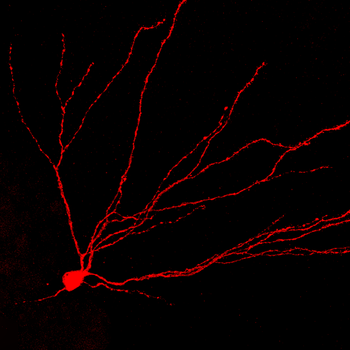Docking stations
Specific molecular complexes in the cell’s outer shell, so-called ‘receptors’, receive the signal by binding the neurotransmitters. This triggers an electrical impulse in the receptor-bearing cell and thus the nerve signal has moved on one neuron further.
In the current study, a team led by Dr Jakob von Engelhardt focused on the AMPA receptors. These bind the neurotransmitter glutamate and are particularly common in the brain. “We looked at AMPA receptors in an area of the brain, which constitutes the main entrance to the hippocampus,” explains von Engelhardt, who works for the DZNE and DKFZ. “The hippocampus is responsible for learning and memory formation. Among other things it processes and combines sensory perception. We therefore asked ourselves how the flow of information into the hippocampus is controlled.”
A pair of helpers
Dr von Engelhardt’s research team specifically focused on two protein molecules: ‘CKAMP44’ and ‘TARP Gamma-8’. These proteins are present, along with AMPA receptors, in the ‘granule’ cells, which are neurons that receive signals from areas outside of the hippocampus. It was already known that these proteins form protein complexes with AMPA receptors. “We have now found out that they exert a significant influence on the functioning of glutamate receptors. Each in its own way, as chemically they are completely different,” says the neuroscientist. “We identified that the ability of a nerve cell to receive signals doesn’t depend solely on the actual receptors; CKAMP44 and TARP Gamma-8 are just as important. Their function cannot be separated from that of the receptors.”
This was the result of an analysis in which the researchers compared brain tissue from mice with a natural genotype with brain tissue from genetically modified mice. Neurons in the genetically modified animals were not able to produce either CKAMP44 or TARP Gamma-8 or both.
Long-term effect
The researchers discovered, among other things, that both proteins promote the transportation of glutamate receptors to the cell surface. “This means they influence how receptive the nerve cell is to incoming signals,” says von Engelhardt.
However, the number of receptors and thus the signal reception can be altered by neuronal activity. The von Engelhardt group found that in this regard the auxiliary molecules have different effects: TARP Gamma-8 is essential to ensure that more AMPA receptors are integrated into the synapse following a plasticity induction protocol, whereas CKAMP44 plays no role in this context. “Synapses alter their communication depending on their activity. This ability is called plasticity. Some of the changes involved are only temporary, others may last longer,” explains von Engelhardt. “TARP Gamma-8 influences long-term plasticity. It makes the cell able to strengthen synaptic communication for a prolonged time-period. The larger the number of receptors on the receiving side of the synapse, the better the neuronal connection.”
The number of receptors doesn’t change suddenly, but remains largely stable for a certain amount of time. “This condition may last for hours, days or even longer. This long-term effect is essential for the creation of memories. We can only remember things if the connections between neurons undergo a long-lasting change,” says the scientist.
Fast sequence of signals
However, CKAMP44 and TARP Gamma-8 also act over shorter periods of time. The research team discovered that the molecules affect how quickly the AMPA receptors return to a receptive state. “If glutamate has docked on to a receptor, it takes a while until the receptor can react to the next neurotransmitter. CKAMP44 lengthens this period. In contrast, TARP Gamma-8 helps the receptor to recover more quickly,” says von Engelhardt.
Hence, CKAMP44 temporarily weakens the synaptic connection, while TARP Gamma-8 strengthens it. Through the interplay of these proteins the synapse is able to tune its sensitivity to a specific level. This condition can last from milliseconds to a few seconds before the strength of the connection is again adapted. Specialists refer to this as “short-term plasticity”.
“These molecules ultimately influence how well the nerve cell is able to react to a rapid succession of signals,” the scientist summarises the findings. “Such a rapid firing enables neuronal networks to synchronize their activity, which is a common process in the brain.”
Sensitive balance
Much to the researchers’ surprise, it turned out that the two proteins influence not only the synapse but also the shape of the nerve cells. In the absence of these auxiliary molecules, the neurons have fewer dendrites to establish contact with other nerve cells. “The organism can use CKAMP44 and TARP Gamma-8 molecules to regulate neuronal connections in a number of ways,” von Engelhardt says. “This ability depends on the balance between the partners, as to some extent they have a contrary effect. The way in which the neurons of the hippocampus react to signals from other regions of the brain is therefore highly dependent on the presence and the expression ratio of these molecules.”
Since the two molecules act directly on the structure and function of synapses of granule cells, Jakob von Engelhardt considers it probable that they also have an influence on learning and memory.
Original publication
Co-expressed auxiliary subunits exhibit distinct modulatory profiles on AMPA receptor function.
Konstantin Khodosevich, Eric Jacobi, Paul Farrow, Anton Schulmann, Alexandru Rusu, Ling Zhang, Rolf Sprengel, Hannah Monyer, Jakob von Engelhardt. Neuron (2014). doi:10.1016/j.neuron.2014.07.004.
A video abstract is availbale at
http://youtu.be/YHT0a7DEuHs

